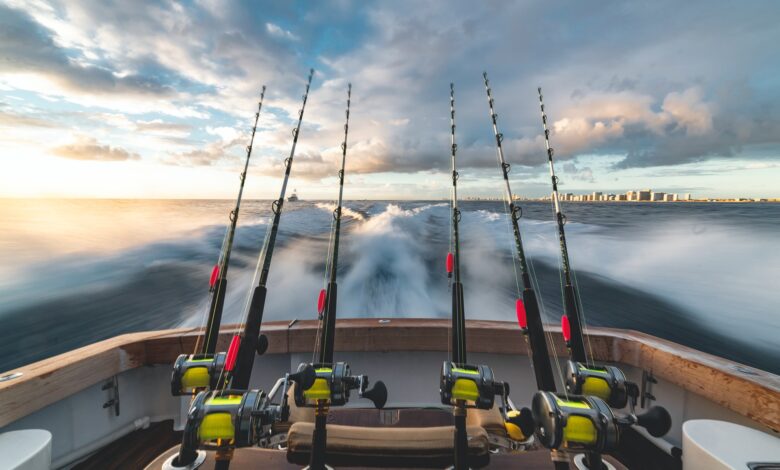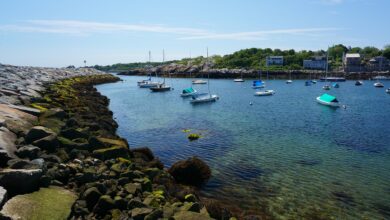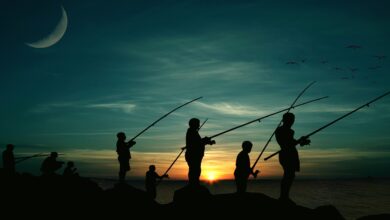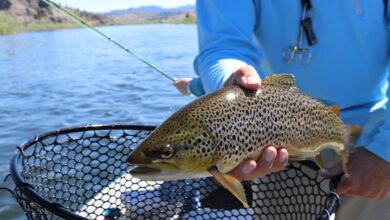Spring is an awesome time for fishing

American Rodsmiths Spring is an awesome time for fishing whether you are working potholes in flooded timber for spawning Bass or working the flats for trophy class Trout and Redfish. It’s just that time of the year that renews the spirit and imbeds the memories that last a life time. I can remember the days coming out of Winter when me and a couple of buddies would just be chomping at the bit to get in the water. Between work schedules and life schedules we finally settled on a day and went hell bent for leather at the water. Coming out of the dreary Winter months just puts that drive in you to GO GO GO FISHING!
You may be a progressing angler that is contemplating a more serious approach to wade fishing. You could be entrenched in the “why jump out of a perfectly good boat” mind set or the “we catch fish in the boat just fine” mindset. Well, wherever your passion lies, here are few things to consider about “making the leap” to the next step in your progression as a fishermen. Perhaps my opinions that follow are something you already know. If so, I’m sure some of my thoughts will find you agreeing whole hearted or perhaps in total disagreement. Regardless, information exchange is the name of the game and the game is FISHING. In my opinion, the most lethal approach to catching fish this time of year is wade fishing with artificial lures. You might be asking, what makes him say that? Keep in mind that this discussion does not focus on the exceptions but what I’ve come to know as “the rule”. It’s not about personal preference, elitist approach or any of that jazz. In fact, I do not believe that wade fishing is “the go to” approach all of the time. There are days when wade fishing game plans can go straight out the window for more appropriate drift fishing with bait or lures or another style of bait fishing. Wade fishing isn’t for everyone and not all wade fishing is for all wade fishermen. Wade fishing can be a “pride swallowing siege” for some that just aren’t over the hump in terms of skill level that will yield enjoyable results. Some have the skill but haven’t developed the right approach mentally or experience wise. Some have the physical ability to wade fish shin deep mud flats and others are limited to harder shell and sand bottoms. All of these things can play a part in the efficacious nature of wade fishing and its applicability for certain anglers. Finding where you are as an angler and “where you want to be” are important considerations. Studying the thoughts that follow may help you get there. Certainly, the more rounded you are as an angler, the better your odds of experiencing great things wade fishing. With that said, what you will find on the water right now is very similar to what you will find in the late Fall and Winter months. There are a few days of rough weather, wind, and off color water followed by a calming trend. The key here is cool water temperatures that necessitate wade fishing.
Cool water, below about 65-70 degrees causes sediments to settle quickly as wind and weather subsides. With water temperatures currently in the mid to upper 50’s, this effect is exaggerated. This leaves much of the fish holding structure covered in clear to “gin clear” water. You know the days I’m talking about. They are the days when you see submerged shell and potholes or other structure never seen before IN SIX FEET OF WATER. These periods are typically found following a cold front. I refer to this time period as “post front” or “post front doldrums” or just plain “doldrums”. I’ve changed this from “post frontal” as in “frontal lobotomy or maybe that’s a bottle in front-a-me”? Anyway, a signature of this period is “high pressure” that flows in behind the cold front and is synonymous with calming winds and mild days. These are the absolute most challenging days that anyone can fish be they Guide or recreational angler. Can you smash the fish following a cold front in the time period I’ve described? The answer would be yes.
Again, however, we are talking about the rule and not the exception. Every year we make a road trip to Port Mansfield at the end of duck season. This year, we canceled our trip to Mansfield because our departure was going to coincide with an arriving cold front. By the time we would have gotten there, we would have been looking at the dregs of the “post front doldrums”. This post front period isn’t good for fishing generally and it certainly isn’t good for duck hunting, goose hunting, or probably anything for that matter. That is what we think of “post front” High Pressure. Now, this applies to cold fronts that are well spaced apart. Back to back cold fronts are another story and that time period when it’s hard to miss fishing. The weather never gets a chance to settle into “the doldrums” and the water stays unsettled. This just always seems to coincide with better fishing. I can tell you that our attitude and expectations are different for sure. This is not to say that during the “post front” period that I have written the day off from the start. No, that is somebody else’s mindset. I am expecting difficulties, however. More that I can attribute to “the rule rather than the exception” is that bait fishing during this post front period can be absolutely horrible. This applies to both Spring and Fall. You may have experienced a trip like this or been with a Guide during something similar. Bright sunshine, a warming break from a cold snap, calm winds, etc., “what great weather for fishing”. If I’ve heard a customer say that once, I’ve heard it a bunch and it is a great misconception. It is the difficulties experienced fishing very clear and settled water that make for challenging fishing. It’s the zone when lighter test lines, flourocarbon, and other “micro fishing” techniques really matter. It’s also a time period that rules out quite a few approaches to fishing right off the bat for me. Here’s what’s going through my mind as I approach a stretch of these days. If I have experienced lure fishermen they absolutely must be capable of wade fishing if production or catching is a concern. You cannot ask for a worse scenario than to have wade capable anglers boat bound during this time period. Drift fishing is out, period. Post front days are marred by slick bays. If there’s no wind, there’s no drifting. Even with enough wind to move the boat a little, the clear water and skittish nature of these highly pressured fish would make me not want to pursue it due to boat noise and inability to cover a substantial amount of water. Add in what typically amounts to fish with a bad feeding attitude during this period and it’s just a mistake. If it’s not a bad feeding attitude, the subtleties of the cold water bite alone dictate a wade fishing approach. How can you spoonfeed a fish while drifting, you can’t. If I am presented with less experienced fishermen, I know that bait fishing is going to be a handful. Forget about drifting with bait like live shrimp. If you can’t drift with lures, you aren’t going to drift with bait. That leaves reef licking and pot licking as another alternative but one to quickly rule out.”Reef licking is the art of anchoring upwind of breakwater on a shell reef or pad and throwing a popping cork with live or fresh dead along the break line to catch Drum, Sheepshead, Redfish and the likes”. It may also be referred to as Pot licking. Well, with no wind there’s no breakwater. For best results, reef licking is a wind driven game. To a point, and I stress to a point, the more wind the better the results. Too much wind can make anchoring very difficult and potentially dangerous given violently pitching boats. Sometimes it can be so rough that it may take several runs at the right angle just to get the boat in the correct position. This to me is getting border line. You may have experienced reef licking under these conditions yourself or with a Guide. This style can produce huge catches and plenty of smiles. The fish box is usually referred to as a “Jail Break” because of all of the striped Sheepshead and Drum. Pot licking comes from the technique of “pot hole bait fishing” and is “the art of fishing sand/grass or mud/grass pockets with live or fresh dead bait typically for Redfish and Drum usually at anchor.” Most anyone that I know professionally is terrified of reef or pot licking amid clear water and calm wind found post front. With the divisions among Texas coastal anglers, some like to poke fun at “pot lickers” and the pot licking bait fishing style in general. I refer to it as an art because that is exactly what it is. There are more than a bunch of Guides that make a living professionally pot licking the flats and reefs and have done so for decades. It may seem a primitive, non-glamorous style of fishing. It’s nuances, however, are not fully appreciated until you do it every day for a living and in any kind of weather with any kind of client. That, in my book, deserves to be referred to as an “art form”. With varied degrees of client skill level, goals or expectations, the vast majority of us do more than our share of “pot licking”.
Did you know that the late Capt. Howard Brown from Rockport was known as President George Bush Sr.’s fishing Guide? His specialty was “pot licking” the flats for Redfish in and around Rockport. Senior did plenty of pot licking on his trips with Capt. Brown. I’ve heard stories about Capt. Brown and senior heading down the intercoastal in Rockport in a convoy surrounded by RHIB’s with secret service suited up and ready for business. I can just imagine the challenges involved in those trips. So, as you can see, this doesn’t leave a warm and fuzzy opinion of alternative approaches to post front wade fishing during Spring and late Fall/Winter. Again, this time period is dominated by post front high pressure and the milder the season, the more it necessitates this type of approach. The following paragraph can pretty much put things into perspective: Wade fishermen this time of year are going to out catch alternative methods and approaches to fishing. This encompasses the number of fish caught, variety, and size. When the weather is rough and rocky they are going to catch more fish and typically larger and better quality fish. When post front doldrums are encountered, wade fishing will out perform all approaches in this difficult period. The catching may not be great, but by and large it will be substantially better than alternative approaches. If you like to drift fish in the boat, are boat bound for physical reasons, or like bait fishing for Redfish during the Spring, one strategy is to suit up for hard weather and pick your days immediately preceding a cold front and on the initial blow. Watch the weather for the onset of the “post front” conditions described and avoid those days like the plague. If you find yourself fishing the “doldrums”, your best bet if you are boat bound or bait fishing is to try to hold out long enough for the wind to start blowing. Therefore, I would watch for the best opportunity to pick up some wind. If it’s blowing early, hit it. If the forecast is for wind late in the day, don’t leave the ramp until much later.
I hope you have found some useful information on these pages and wish you the best of fishing in days to come. Nothing in the fishing world is written in stone and I fish every day like there’s no tomorrow. Keep these thoughts in mind and use them in your planning and strategy sessions. When you find the exception to what I’ve written here, make a note in your logbook because you won’t see it again for some time. Those are the special days that you defy the odds and push back that waterhaul Gremlin once again.



